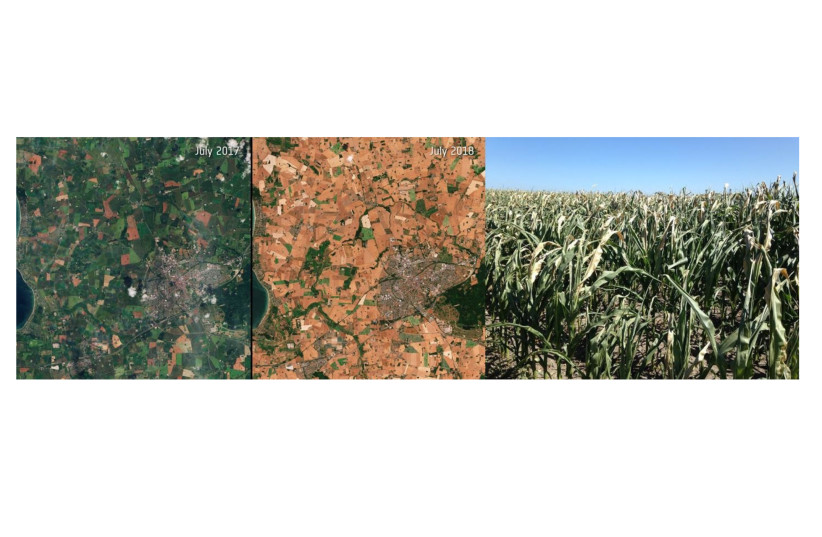70% of topsoil will likely see a reduction in water content over the next 100 years.
By ALDEN TABAC
Published: JULY 26, 2022

As the planet warms, mechanisms underlying ecosystems will change to be more like dryland areas, according to a new study published Thursday.
Led by Prof. José Grünzweig of the Hebrew University of Jerusalem, a team of researchers including Dr. Omer Tzuk and Prof. Ehud Meron of the Ben-Gurion University of the Negev argued that mechanisms prevalent in dry regions will become a feature of historically wetter climatic zones.
The peer-reviewed study analyzed 12 different dryland mechanisms that affect the functioning of ecosystems. These included the fast-responding mechanisms of dry-wetting cycles, hydraulic redistribution, humidity-enhanced biotic activity, soil hydrophobicity, photochemical degradation and thermal degradation, and the slow-responding mechanisms of biological soil crusts, self-organization of vegetation patchiness, wind- and water-driven horizontal resource redistribution, decoupling of soil biogeochemical cycles and canopy convector effect.
“Long-term gradual trends of increasing aridity and warming will lead to continuing declines in soil moisture and increases in the soil surface and air temperatures,”
According to the study
“Long-term gradual trends of increasing aridity and warming will lead to continuing declines in soil moisture and increases in the soil surface and air temperatures,” the study noted. “In addition to the dryland mechanisms operating on the small scales, these trends may promote slow-responding mechanisms on large spatial scales.”
Dryland mechanisms are already spreading
Dryland mechanisms continue to occur in temperate regions with increasing frequency, a press release from Ben-Gurion University explained. “In the future, these also will likely increase in frequency and become more relevant due to warmer, drier conditions from climate change.“
Left and middle: Impact of the extreme heatwave and drought of summer 2018, as compared to summer 2017, on fields around the town of Slagelse in Zealand, Denmark ; Right: Danish maize field in July 2018 (credit: European Space Agency and Janne Hansen)
In 2018, a drought affected a large part of Europe, likely leading to ecological processes in wet regions that would normally only occur only in deserts, according to the release. The extreme temperatures plaguing the continent this summer will lead to the exposure of bare soil that is usually covered by plants, making the ecosystem dryer.
Researchers in the study predicted that topsoil worldwide will become significantly drier over the course of the next 100 years. South America, Africa and Oceana are set to experience the largest shifts in soil dryness. Overall, 70% of the planet’s total terrestrial area will see a decline in soil surface water content according to modeling projections.
Moreover, the total area of land other than dryland that is predicted to reach topsoil temperatures above 40 C in the next 100 years is a whopping 17,000,000 km2. For reference, that is equivalent to the surface area of the US and Brazil combined.
The study, therefore, concluded that “mechanisms observed in drylands will come into play in historically non-water-limited mesic, humid and cold regions.” When these mechanisms take effect in new regions, they will be able to amplify the impacts of climate change on other ecosystems. They also affect basic ecosystem properties including water flow, vegetation organization and decomposition of organic matter.
The changes will affect people
“Alterations of the mechanisms underlying ecosystem functioning have immediate consequences for ecosystem services, that is, nature’s contributions to people,” the study stated. “Some of the projected changes will occur in regions with large human populations, especially in subtropical and mid-latitudes, and thus will substantially affect the well-being of society in these regions.”
Going forward, the researchers plan to look at how ecosystems function under droughts and heatwaves. New insights yielded from such research will contribute to the capacity to withstand climate extremes and help reduce the impacts they have on people, according to the press release.
“This knowledge can be conveyed to stakeholders to inform and direct environmental policy in its efforts to adapt to consequences of climate change for humans and nature,” the researchers wrote in the study.

